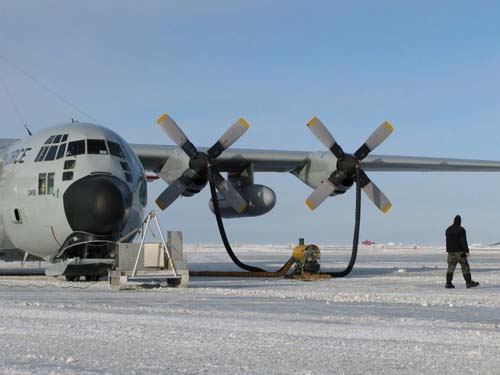Airmen played a huge role in transporting a seriously injured Australian researcher earlier this week from Antarctica to a hospital in Hobart, Australia during a multi-day mission covering thousands of miles over barren terrain and in the face of some treacherous weather. The man had suffered multiple fractures in an all-terrain-vehicle accident. A combined US-Australian medical team assembled in Christchurch, N.Z., for a flight aboard a New York Air National Guard LC-130 ski-equipped transport to McMurdo Station, Antarctica. On Nov. 3, the LC-130, from the NYANG’s 109th Airlift Wing, carried them another 1,500 miles to Davis Station, Antarctica, where it landed on an improvised runway to retrieve the injured man. On Nov. 4, the LC-130 made the 10-hour flight to Hobart. The LC-130 is a part of US Pacific Command’s Joint Task Force Support Forces Antarctica, headquartered at Hickam AFB, Hawaii, which supports US scientific research on the southernmost continent under Operation Deep Freeze. Capt. Greg Richert, the on-board flight surgeon, said the successful mission demonstrated “the very effective medical movement capability” that the US has in the Pacific region and the strong US-Australia partnership. The mission was the first major action for the LC-130 during the current Deep Freeze season, which began in early September. But it was the second medical evacuation so far. In mid September, airmen utilized a C-17 to transport a member of the National Science Foundation research team who needed cardiovascular evaluation back to New Zealand. (For more, read yesterday’s Sydney Morning Herald report) (Includes Hickam report by Maj. Sam Highley)
played a huge role in transporting a seriously injured Australian researcher earlier this week from Antarctica to a hospital in Hobart, Australia during a multi-day mission covering thousands of miles over barren terrain and in the face of some treacherous weather. The man had suffered multiple fractures in an all-terrain-vehicle accident. A combined US-Australian medical team assembled in Christchurch, N.Z., for a flight aboard a New York Air National Guard LC-130 ski-equipped transport to McMurdo Station, Antarctica. On Nov. 3, the LC-130, from the NYANG’s 109th Airlift Wing, carried them another 1,500 miles to Davis Station, Antarctica, where it landed on an improvised runway to retrieve the injured man. On Nov. 4, the LC-130 made the 10-hour flight to Hobart. The LC-130 is a part of US Pacific Command’s Joint Task Force Support Forces Antarctica, headquartered at Hickam AFB, Hawaii, which supports US scientific research on the southernmost continent under Operation Deep Freeze. Capt. Greg Richert, the on-board flight surgeon, said the successful mission demonstrated “the very effective medical movement capability” that the US has in the Pacific region and the strong US-Australia partnership. The mission was the first major action for the LC-130 during the current Deep Freeze season, which began in early September. But it was the second medical evacuation so far. In mid September, airmen utilized a C-17 to transport a member of the National Science Foundation research team who needed cardiovascular evaluation back to New Zealand. (For more, read yesterday’s Sydney Morning Herald report) (Includes Hickam report by Maj. Sam Highley)
The Air Force plans to have its new Integrated Capabilities Command stood up by the end of 2024, Chief of Staff Gen. David W. Allvin said May 2, offering new details of one of the signature reforms announced by the service earlier this year. Allvin said around 500-800 Airmen will…